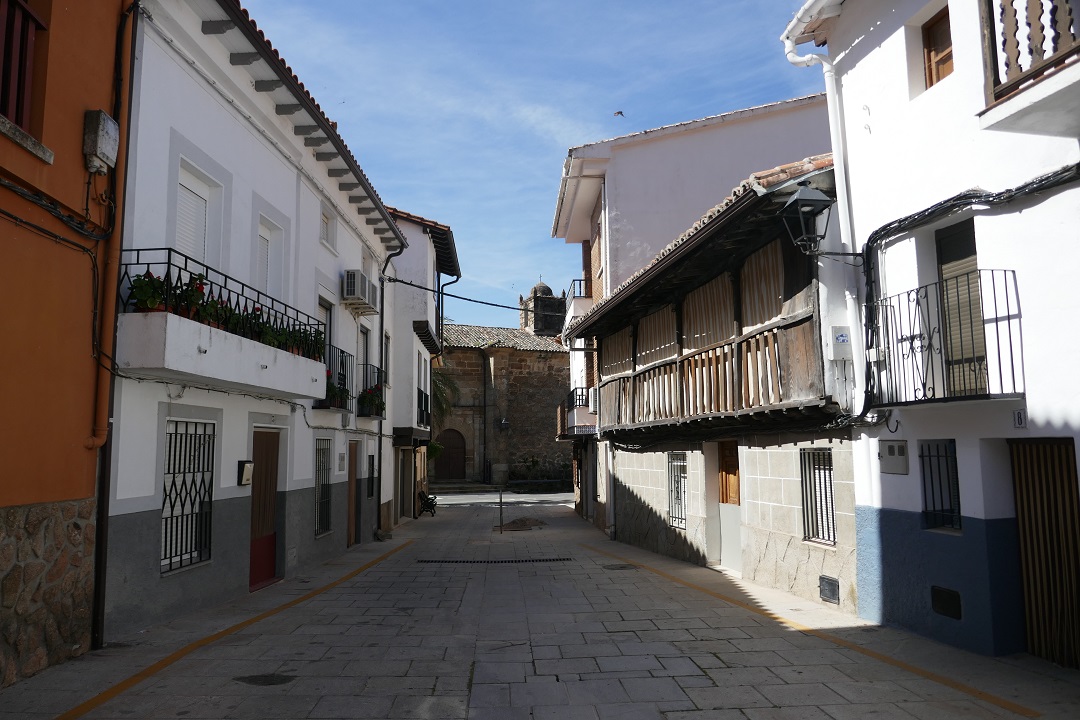Cáceres province: an essential guide for travellers
Location and population
Cáceres is one of the region’s two provinces. Located in northern Extremadura, it borders Portugal to the west, Castilla y León to the north, and Castilla-La Mancha to the east. With an area covering 19,868 square kilometres, Cáceres is the second largest province in Spain.

The province has a population of under 390,000. Over 95,000 people live in its capital city, which is also called Cáceres. Only three other places have a population over 10,000, with the vast majority of cacereños living in smaller towns and villages. As a result, Cáceres province is sparsely populated, with a very low population density of under 20 people per square kilometre.
Areas in Cáceres province
For the purposes of this website, I have divided Cáceres province into sixteen travel areas, which are displayed on the map below. Click on the yellow pins to reveal the area, the largest destination in that area, a place of interest and a link to the area travel guide (if available).
All sixteen province areas are also listed in alphabetical order below.
Cities in Cáceres province
Two places fit my description of ‘city’ (destination with a population of over 25,000) – Cáceres and Plasencia.
Cáceres

Cáceres is the province’s capital, a World Heritage City and one of Extremadura’s main tourist destinations. It features outstanding buildings of different historical periods and architectural styles and a variety of good quality restaurants.
Plasencia

Plasencia is a small city featuring a unique two-in-one cathedral and a rather vibrant cultural and nightlife scene. Due to its strategic location, it’s generally considered the gateway to explore Extremadura’s northern valleys.
Towns in Cáceres province
Two places fit my description of ‘town’ (destination with a population ranging from 10,000 to 24,999) – Navalmoral de la Mata and Coria.
Navalmoral de la Mata is the largest town in the Campo Arañuelo area, in northeastern Cáceres province, while Coria is the largest town in the Valle del Alagón area, in northwestern Cáceres province.
Featured small towns
Trujillo

Trujillo is located in the Miajadas-Trujillo area. Boasting one of the country’s most beautiful squares and numerous fine historical buildings, Trujillo is also a good base for birdwatching.
Hervás

Hervás is located in the northern Valle del Ambroz area and features one of Spain’s best-preserved Jewish quarters. Its beautiful natural surroundings offer lots of walking routes particularly well-suited for autumn.
Featured villages
Guadalupe

Guadalupe is located in the Villuercas-Ibores-Jara area. Home to the Royal Monastery of Santa María de Guadalupe, a UNESCO World Heritage Site, it also features some good examples of traditional architecture and local food products.
Casares de las Hurdes

Casares is located in Las Hurdes, Extremadura’s northernmost area. The municipality comprises six tiny villages with a total population of just over 400 people. It’s a great place for scenic driving, wild swimming and switching off.
Granadilla

Granadilla is a former village of medieval origins located by the Gabriel y Galán reservoir, in the Trasierra-Tierras de Granadilla area. Abandoned in the sixties, today Granadilla is a ghost town featuring a castle worth a detour.
Small villages in Extremadura

One of my goals is to bring visibility to little places often overlooked and rarely featured in online and offline travel publications. This article compiles all the small villages in Extremadura that I have visited so far.
In Cáceres province you’ll also find
- Extremadura’s highest town: Piornal, located in the Valle del Jerte area at 1,175 metres over sea level.
- Extremadura’s highest point reachable by car: Risco Villuercas, located in the Villuerca-Ibores-Jara area, at 1,601 metres over sea level.
- Extremadura’s northernmost place: Ladrillar, located in Las Hurdes area.
- Extremadura smallest village: Pedroso de Acim, with a population of 73, is located in the Monfragüe and surroundings area.
- Extremadura’s oldest man-made structure: Cueva de Maltravieso, a 66,700-year-old cave located within Cáceres municipality.
- Extremadura’s oldest standing church: Santa Lucía del Trampal, a seventh-century Visigoth church located in the Sierra de Montánchez y Tamuja area.
- Extremadura’s only National Park: Parque Nacional de Monfragüe.
